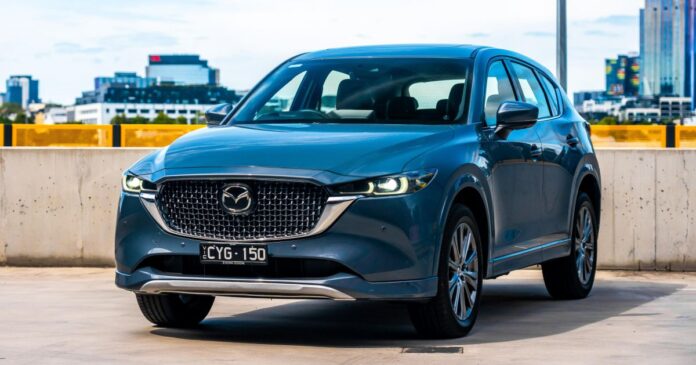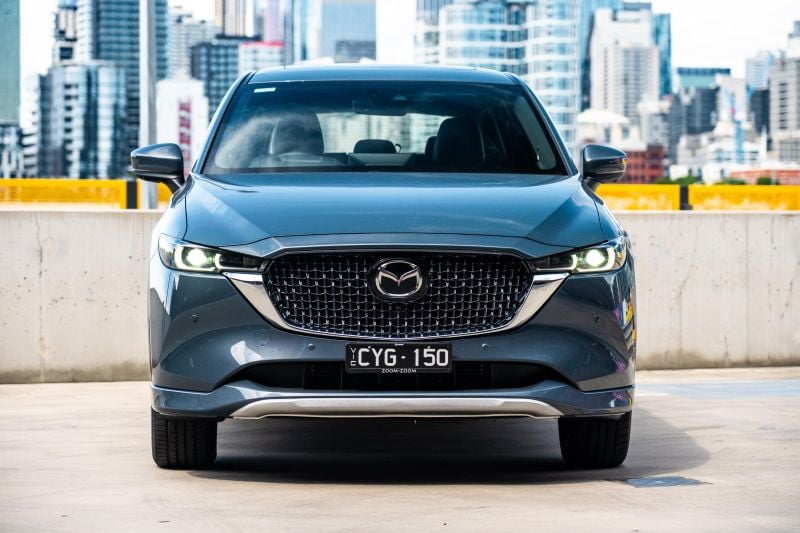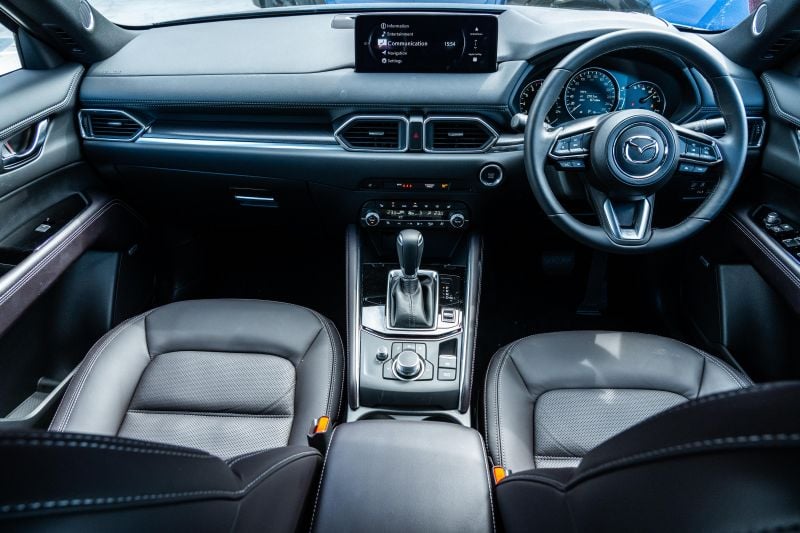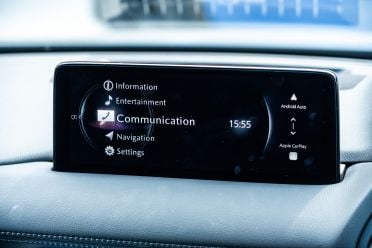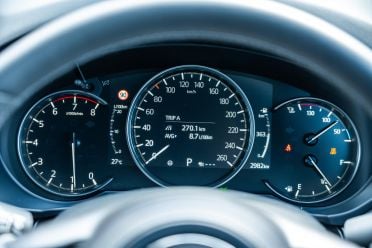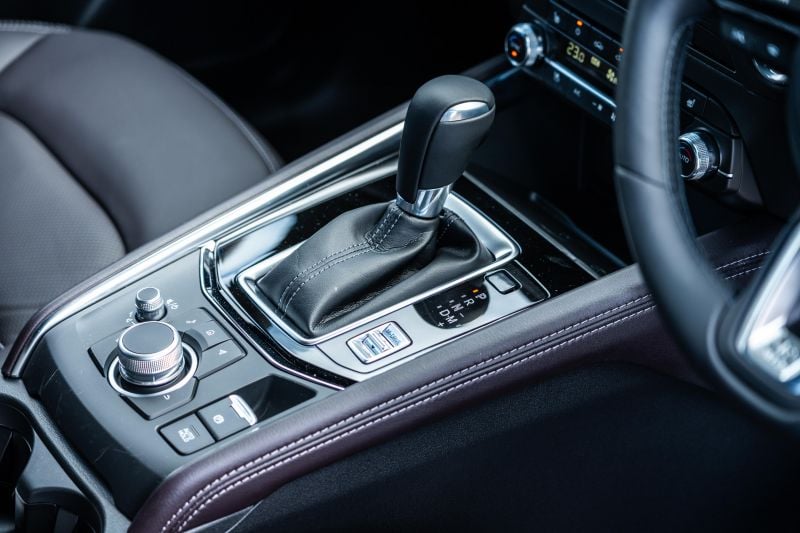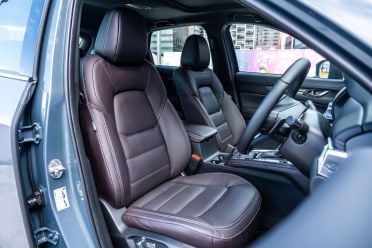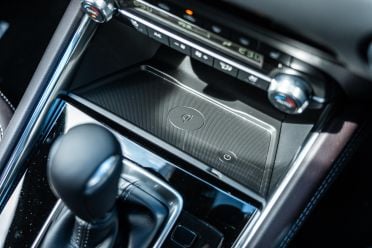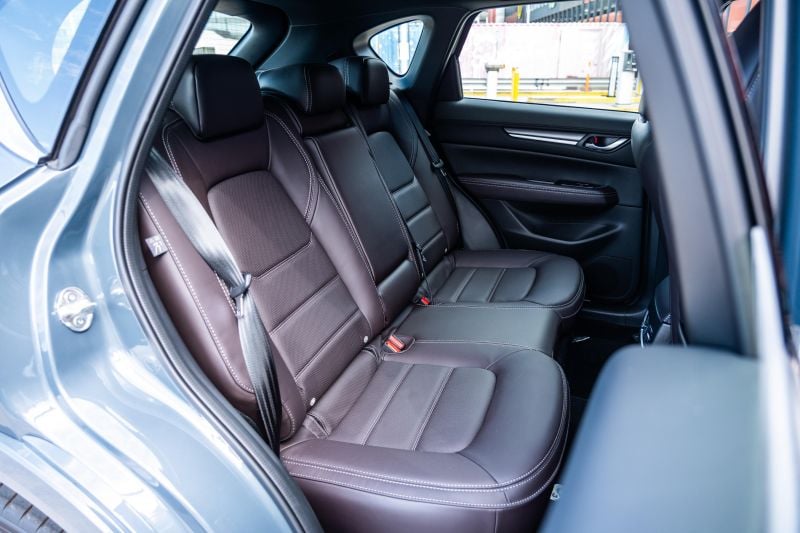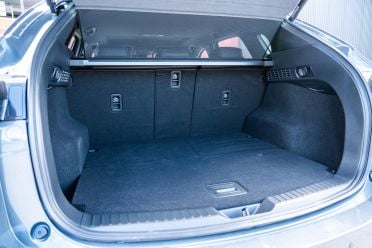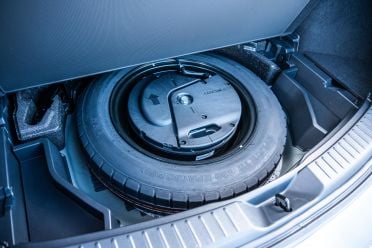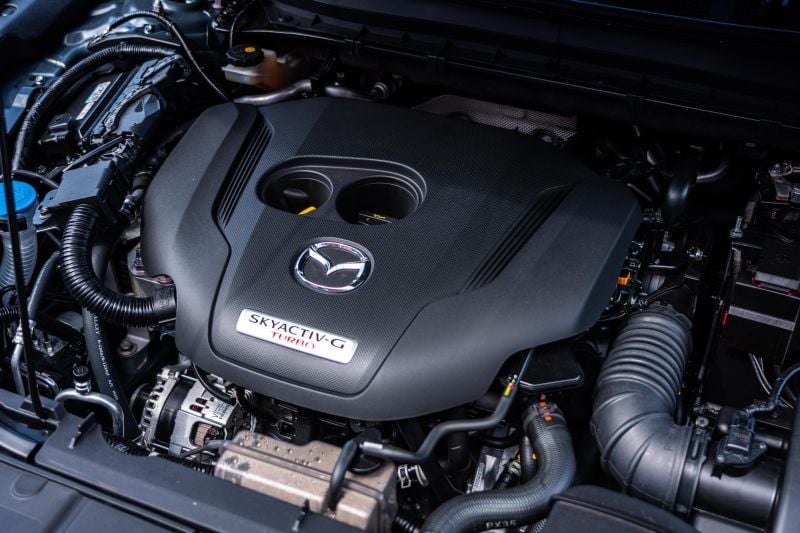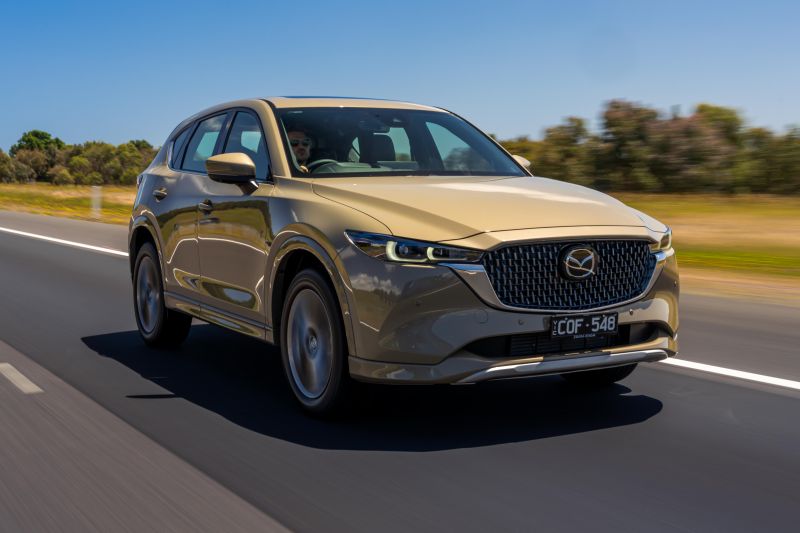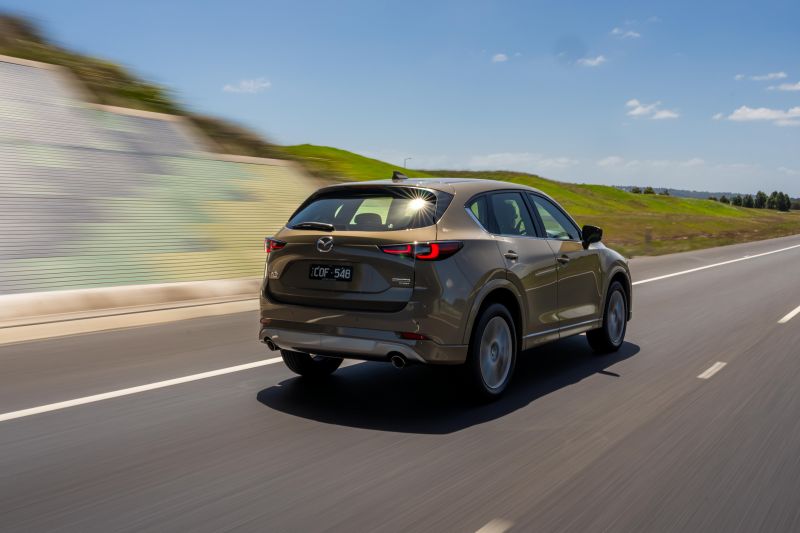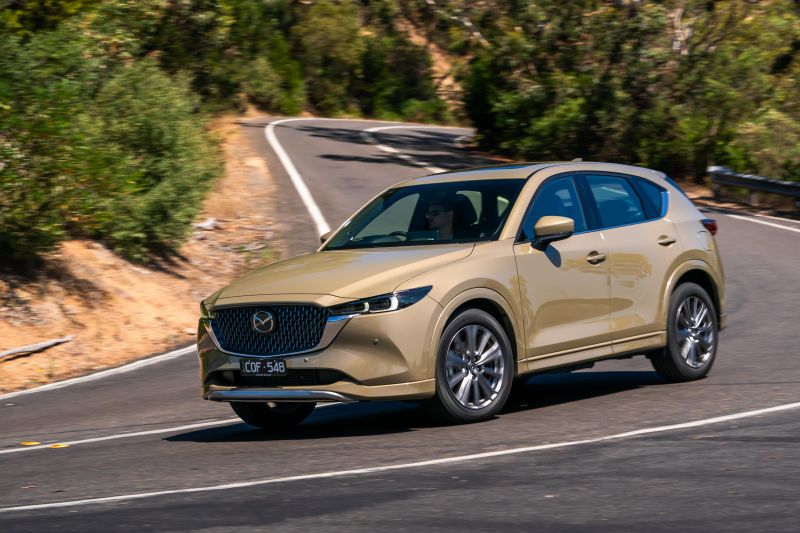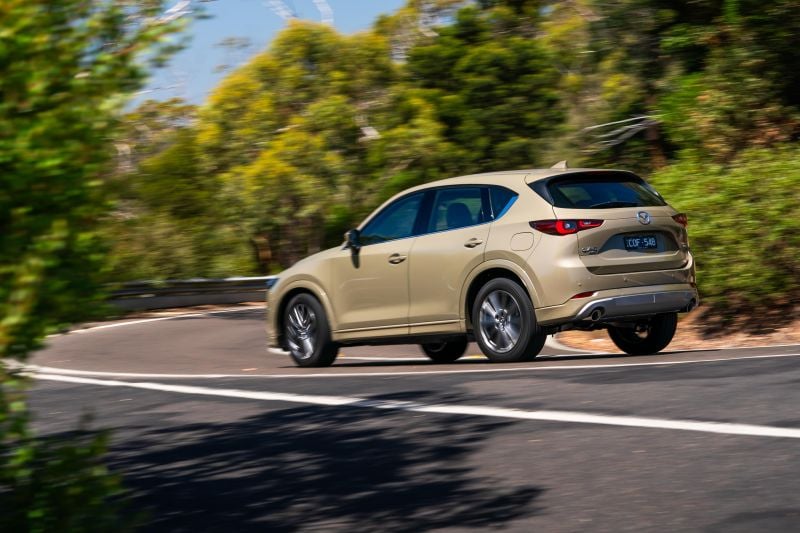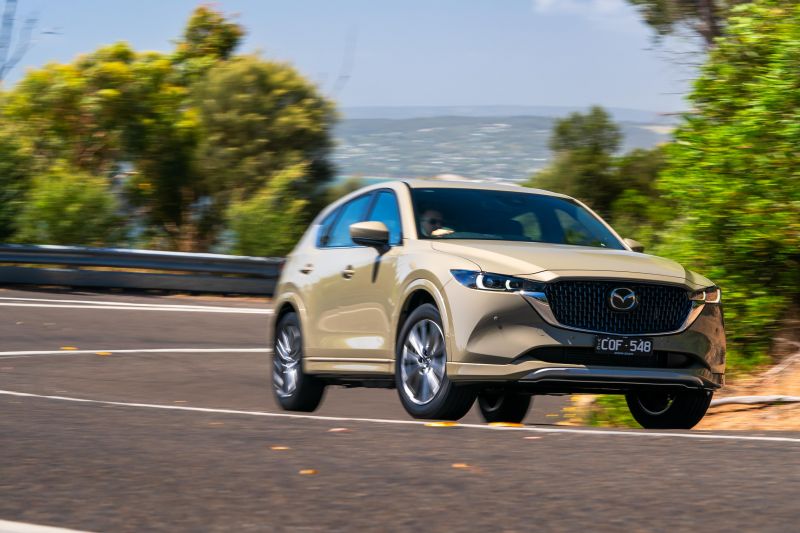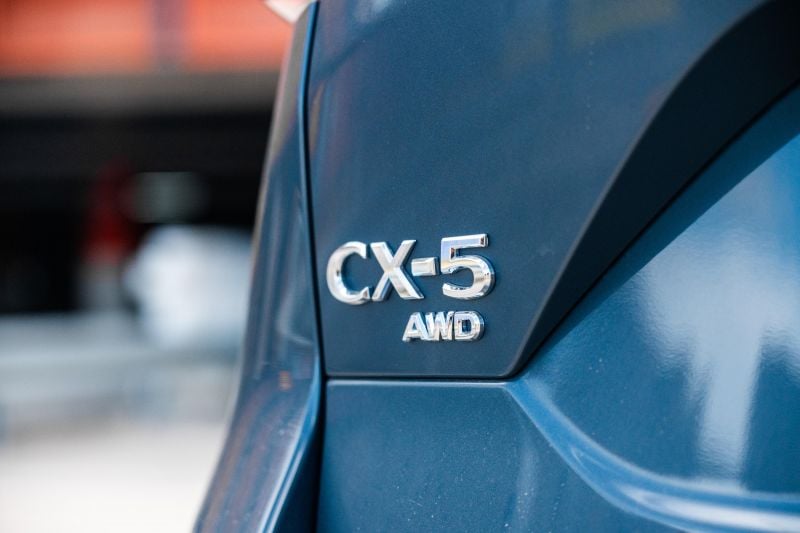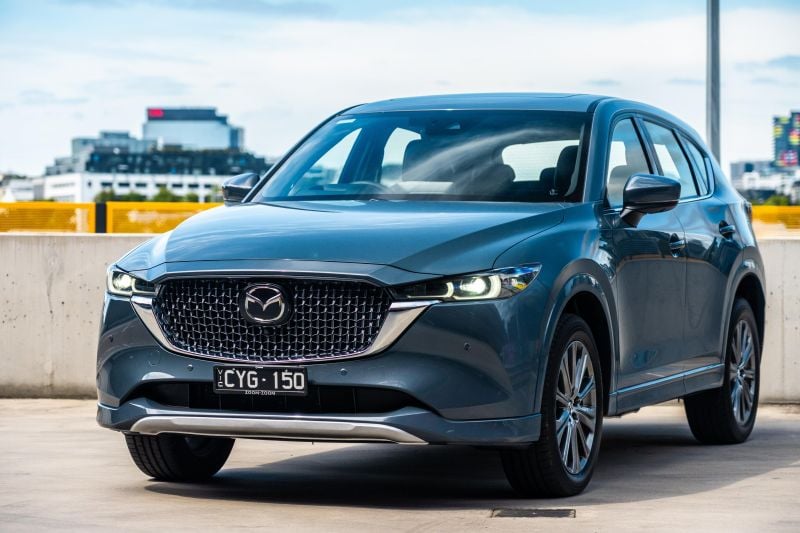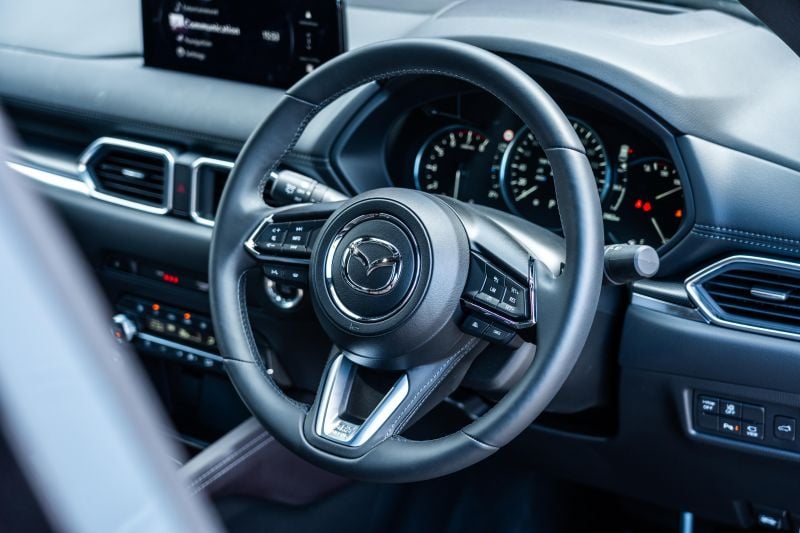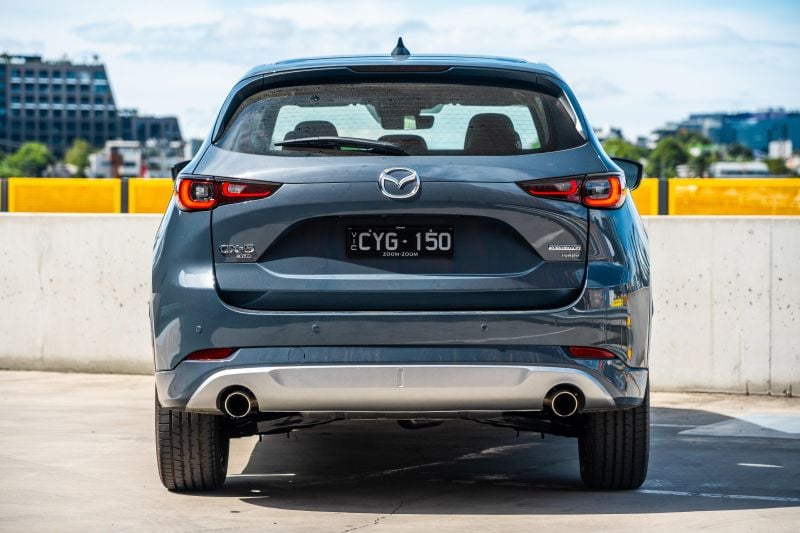An updated Mazda CX-5 may be just months away, ahead of an all-new model next year, but there’s a lot to like about the mid-size SUV you can currently buy – even if it dates back to 2016.
Set to arrive in June, the updated CX-5 range will bring a revised model lineup, with the main change being the addition of a front-wheel drive version of the mid-spec Touring to replace the all-wheel drive Maxx Sport.
Tech and gear previously found only at the top of the range will soon also trickle down to cheaper variants. That makes the range more accessible and means people who want the best of Mazda’s equipment won’t have to pay as much.
Those at the top rarely concern themselves with the quarrels of those at the bottom though, and that rings true with the CX-5 flagship. The Akera will remain largely unchanged at the very top of Mazda’s mid-size SUV range.
It’ll still have a potent turbocharged engine and all-wheel drive as standard, as per the GT SP positioned below it. What’s not yet known is how much it’ll cost, and that’s where the existing model range enters the picture.
The current generation of CX-5 went on sale in Australia in 2017, and since then several adjustments have been made to the range. A facelifted version arrived in early 2022, the manual was dropped in late 2022, and diesel engines were axed for 2024.
WATCH: Paul’s video review of the 2024 Mazda CX-5 G25 Touring AWD
That gives us the petrol-only range we know today. Despite exceptionally strong competition, the CX-5 remains a sales winner and holds a price advantage over its rivals.
In 2024, Mazda shifted 22,835 CX-5s, placing it behind only the Toyota RAV4 with 58,718 and Mitsubishi Outlander with 27,613 in the mid-size SUV segment. It beat rivals like the Kia Sportage (22,210), Hyundai Tucson (19,061), and Nissan X-Trail (17,494) to the bronze medal.
The breadth of the CX-5 range no doubt helped it reach those numbers. While there’s no hybridisation available – a key omission in the context of the above rivals – there are five trim levels, three engines, and two drivetrains to choose from, providing something for everyone.
On test here is the range-topping Mazda CX-5 G35 Akera AWD, the only CX-5 variant priced at more than $54,000 before on-roads. This is as good as the existing CX-5 gets, so should you bide your time and wait for the updated model or even its all-new replacement, or opt for one of its many rivals?
How does the Mazda CX-5 compare?
View a detailed breakdown of the Mazda CX-5 against similarly sized vehicles.

Mazda
CX-5
How much does the Mazda CX-5 cost?
The Akera is one of just two CX-5 trim levels available with a turbocharged engine and all-wheel drive. It’s also the more luxe version of the pair and costs a square $55,000 before on-roads.
| Model | Price before on-road costs |
|---|---|
| 2025 Mazda CX-5 G20 Maxx FWD | $36,950 |
| 2025 Mazda CX-5 G25 Maxx Sport FWD | $40,310 |
| 2025 Mazda CX-5 G25 Maxx Sport AWD | $42,810 |
| 2025 Mazda CX-5 G25 Touring AWD | $44,950 |
| 2025 Mazda CX-5 G25 GT SP AWD | $50,310 |
| 2025 Mazda CX-5 G25 Akera AWD | $52,500 |
| 2025 Mazda CX-5 G35 GT SP AWD | $52,810 |
| 2025 Mazda CX-5 G35 Akera AWD | $55,000 |
In terms of top-spec rivals, the hybrid-only RAV4 tops out at $58,360, the non-hybrid Outlander lineup at $55,190, and the Sportage at $55,420 – all prices are before on-road costs.
The CX-5 is also cheaper than the range-topping Tucson and Nissan X-Trail variants yet costs more than the equivalent but slower-selling Subaru Forester.
As mentioned, there’s a set of running changes coming soon for the CX-5 that will bring some shuffling of the variants and more standard kit further down the range, though the Akera will remain unchanged.
To see how the Mazda CX-5 stacks up against its rivals, use our comparison tool
What is the Mazda CX-5 like on the inside?
Really quite nice and really quite similar to most other Mazda interiors.
Even alongside premium Mazdas like the larger CX-70, this is still up there with the nicest interiors the Japanese brand offers.
The biggest omission is a fully digital instrument cluster, but what you get in the CX-5 still looks classy. As there are buyers who want a full screen and others who want only gauges, we feel Mazda’s approach here is a solid compromise.
In fact, it’s practically identical to what you get in a Mazda 3, and we like it there too. Configuration isn’t its strength though, as there are only a couple of displays to scroll through on the 7.0-inch digital portion – done by using the ‘Info’ button on the steering wheel.
All the information presented is clear and legible, contributing to the instrument unit’s overall clean look. Our preferred display is the fake speedometer gauge, even if it defeats the point of a digital cluster.
A strength is the CX-5’s 10.25-inch infotainment display, which is standard across the range and holds its own against the larger displays in Mazda’s larger SUVs.
Unlike lower-spec CX-5 of recent years or even the current CX-3, the screen in the current CX-5s is the latest in Mazda multimedia hardware. It’s still jammed into the top of the dashboard, but it’s a crisp display with reliable functionality.
It is, however, annoying that you can’t use it as a touchscreen while on the move. As standard, you’re forced to operate it via the rotary dial and buttons on the centre console, which is still the cheaper-looking alternative to what’s in cars like the Mazda 3 and CX-70, for instance.
That’s certainly not for everyone, but I’ve always liked this setup. There’s something nice about being able to lean on the central armrest as you scroll through the screen rather than lifting your arm – first-world problems, I know.
Mazda has provided a box you can tick to unlock the touchscreen function, which is especially helpful for Apple CarPlay. We like the wireless functionality, but navigating it using the dial is cumbersome.
The dial works well with Mazda’s native user interface, especially once you’ve figured out some navigational tricks like pulling the dial down to jump to smartphone mirroring.
Also functional is the CX-5’s climate control system. Again, it’s nowhere near as extravagant as a larger Mazda SUV’s, but it’s easy to use, thanks to its primarily physical setup.
Otherwise, we appreciate the material choice inside, except for the gloss black panel surrounding the gear selector. The key touch points are all soft and padded, making it easy to settle in for a longer drive.
The well-proportioned driver’s seat is supplemented by electric adjustment, for which there’s a wide range of movement. The same is true for the steering wheel, which offers good tilt and reach adjustment to suit most seating positions.
With its large diameter and thin rim, the wheel itself feels quite nice in the hands. The leather finish is also smooth and fits perfectly in a cabin like the Akera’s, and we don’t hate its chrome accents and hardy buttons.
You’ll notice the distinct lack of brightly coloured upholstery here too, which isn’t consistent with specific grades of the CX-3 and Mazda’s larger SUVs. That makes it friendlier for young families prone to major spills.
That said, the Akera is the only CX-5 available with “Dark Russet” Nappa leather. All that means is you get material that looks a bit more premium without having to worry about dirtying the tan-coloured suede or white leather also available.
Everything is nice and comfortable as a result. We’d stop short of calling it high-end, but there’s a certain budget-conscious luxury to the way everything’s presented.
As for storage and connectivity, you have two central cupholders, bottle holders in the doors, and a sizeable centre console storage box – not to mention a wireless charging pad tucked away underneath the climate panel, well out of reach of the sun’s hot rays.
There are also two USB-C ports up front, which can be used for charging and smartphone mirroring. As a whole, the interior design and layout are impressively cohesive, not to mention surprisingly premium.
That theme continues to the second row. Back here is the same almost-black upholstery, which covers a nicely padded bench seat.
Headroom is excellent thanks to the CX-5’s tall roofline, and passengers back here likely won’t run into any issues with legroom either. There’s even enough space to fit three grown adults with relative ease.
Amenities in the back of the Akera include rear-facing air vents to complement the dual-zone setup, plus heating for the outboard seats. There’s also a fold-down central armrest, where you’ll find two cupholders, buttons for seat heating, and a unique power bank with two USB-A charging ports.
It’s mildly disappointing that the Akera’s sunroof isn’t panoramic and therefore doesn’t cover the second row.
That said, I’m a fan of Mazda’s all-black headliner, as it elevates the upmarket environment inside the cabin.
It also contributes to making the CX-5 feel a bit smaller from behind the wheel, which helps for an SUV of this size, without making the cabin feel cramped or closed-in. It’s nowhere near as cozy as a Mazda 3 feels inside.
Out back, the boot is big and practical. It may offer less capacity compared to rivals like the RAV4 (up to 580 litres) and the petrol Tucson (539 litres), but the carbo floor is still long, flat and level with the boot opening to making loading easier.
The CX-5’s rear wheel-arches eat into cargo capacity, and Mazda has added two relatively shallow storage nooks behind them on either side. There are also cargo hooks above them and a retractable privacy cover on top.
Lifting the boot floor reveals a space-saver spare wheel, which is standard across the range. There are additional storage spaces to be found here too, if you need to eke out some extra room.
There’s not a lot to complain about regarding the CX-5’s interior, especially at the pricier Akera level.
To address those minor first-world problems, we wouldn’t complain if a larger sunroof was installed and the few bits of glossy black plastic were removed, but we find the overall cabin design easy on the eye and comfortably liveable.
| Dimensions | Mazda CX-5 G35 Akera |
|---|---|
| Length | 4575mm |
| Width | 1845mm |
| Height | 1680mm |
| Wheelbase | 2700mm |
| Cargo capacity (VDA) | 438L (rear seats up) 1340L (rear seats folded) |
To see how the Mazda CX-5 stacks up against its rivals, use our comparison tool
What’s under the bonnet?
Our Akera was fitted with Mazda’s turbocharged G35 petrol engine, a 2.5-litre four-cylinder producing the most power of any engine across the CX-5 range. It delivers 30kW of power and a big 168Nm more torque than its naturally aspirated equivalent, and continues with the six-speed torque converter automatic that’s standard across the range.
| Specifications | Mazda CX-5 G35 |
|---|---|
| Engine | 2.5-litre 4cyl turbo-petrol |
| Power | 170kW @ 5000rpm |
| Torque | 420Nm @ 2000rpm |
| Transmission | 6-speed automatic |
| Drive type | All-wheel drive |
| Kerb weight | 1730kg |
| Fuel economy (claimed) | 8.2L/100km |
| Fuel economy (as tested) | 9.7L/100km |
| Fuel tank capacity | 58L |
| Fuel requirement | 91 octane regular unleaded |
| CO2 emissions | 191g/km |
| Emissions standard | Euro 5 |
| Braked tow capacity | 2000kg |
Our week with the car involved primarily suburban driving, with a handful of freeway stints thrown in for good measure. With that in mind, our recorded fuel economy was on par with Mazda’s urban cycle claim of 10.3L/100km.
Mazda’s combined claim is quite high for what’s a fairly standard family commuter – a direct result of the high-output engine under the bonnet. Naturally, we had to plant the foot a few times to see what it could do.
To see how the Mazda CX-5 stacks up against its rivals, use our comparison tool
How does the Mazda CX-5 drive?
It might not deliver its extra performance in the most inspiring fashion, but Mazda has seasoned this CX-5 with something a little spicier than what we’re used to with Australia’s single most popular new vehicle type.
In one sense, the turbocharged G35 engine in the CX-5 is a catch-22 – it makes this family SUV a lot faster, but it undermines the fuel economy benefits that define the best family SUVs.
On the other hand, the G35 brings the CX-5 to life. It’s surprisingly quick, especially when you’re able to capitalise on that near-instant torque hit at low speed.
The CX-5 has no issue getting its power to the ground either, thanks to its well-sorted all-wheel drive system. A bonus is how effortless the engine makes normal driving feel, as it’s able to happily chug along at highway speeds and gently accelerate without having to drop down a gear.
In the context of the 2.0-litre engine at the bottom of the range, the G35 is quite a refined option too. Of course, the downside is higher fuel consumption, which is something you’ll have to accept if you go for this configuration.
Mazda’s fuel economy claim won’t be at all surprising to buyers coming from an SUV from the mid-2000s, but it’s well above what the other two CX-5 engines are claimed to consume. At least its ability to cope with regular 91-octane fuel soothes the sting.
In real-world driving, you likely won’t be able to match Mazda’s claim. It’s easy to lose track of how much you’ve actually drank until you check the trip computer and make the shocking revelation.
As such, the non-turbo 2.5-litre is probably the better alternative. There’s no questioning the better performance of the G35, but you’ll have to weigh up whether you want a bit more urge or to save a bit more at the bowser.
The turbo does ease the strain on the engine, which can actually save fuel during low-demand driving, but there’s no cylinder deactivation tech like with the G25. What we don’t love is the CX-5’s transmission, which is an unfortunate theme across Mazda’s automatic catalogue.
It just doesn’t react quickly enough to sharp throttle inputs. When trying to accelerate quickly from low speeds, it’ll take a fair while to kick down to the appropriate gear – before the G35 really takes off.
Shifting under high load is consistent, though power delivery tends to peter out as you get closer to the top of the rev range, and it becomes time to grab the next gear. It’s low-speed, suburban driving where the transmission can get in the way by being a little sluggish.
You can take control yourself using the paddle shifters on the wheel, but don’t expect lightning-quick shifts. Generally speaking, the gearbox is fine for the job it needs to do, but it’s just not as snappy as we’d like for an engine producing as much power as this.
As for ride comfort, the CX-5 is well sorted. While there’s no adaptive suspension tech, the spring and damper setup manages the Akera’s size and weight well.
It handles large rises and dips confidently and irons out smaller imperfections in a way that won’t tire you out on long drives. That’s despite the larger 19-inch wheels fitted to the Akera, though the chunkier rubber fitted on the base CX-5s makes the ride even comfier.
Road noise is a similar story. The Akera is quieter than we’d expect from an eight-year-old model on low-profile tyre, but the cabin is well insulated and its aerodynamic shape minimises wind noise too.
Despite all this body and chassis refinement, handling is crisp and, as a bonus, there’s still a somewhat mechanical feel to the steering. It’s direct and weighty without being cumbersome, making the CX-5 appropriately agile as a result.
You also get the peace of mind of all-wheel drive, providing a touch more traction on wet or unsealed roads. This is standard for all CX-5s, bar the bottom two variants.
So the driving experience of the CX-5 is confidence-inspiring and its safety tech is a big reason for this. While the CX-5 is no longer rated by the independent ANCAP safety organisation, there’s a comprehensive suite of gear in the Akera – as you’d expect for a top-spec model.
Among them is Mazda’s more advanced cruising and traffic support system. This is only found on the GT SP and Akera, and it works well to keep the car centred in its lane while matching the speed of traffic around you.
Long-distance driving is therefore very easy in the Akera, and the comfortable and spacious interior make it even better suited to racking up time being the wheel. Additionally, other safety systems like blind spot monitoring can generally be trusted, while its reversing camera is of acceptable quality.
The Akera is also the only CX-5 to be fitted with a surround-view camera, which works well, is great to have and should make you feel better about paying extra for the top-shelf CX-5.
All of this is backed up by generous visibility out of the cabin. The seating position is relatively high and makes seeing over the bonnet easy, while the side windows are large enough for quick head-checks.
The only thing that could be considered an inconvenience is the rear window, which appears quite narrow when looking through the rear-view mirror. It’s not the end of the world, but the tailgate can obscure smaller cars with lower rooflines – especially in low light conditions.
All up, this is a strong, cohesive package, though the highlight is definitely that engine. The performance advantage may not justify the extra money when you consider the trade-off in fuel efficiency, but it adds a bit of character to the CX-5 and suits its sporty chassis well.
Unlike the bigger and newer CX-60, for example, we have no complaints with ride comfort, and those minor transmission niggles are by no means a deal-breaker.
The solid foundations of this CX-5 are good enough to make it Mazda’s top-seller and even Australia’s most popular mid-size SUV for a while, and they still stack up well alongside its latest competitors.
To see how the Mazda CX-5 stacks up against its rivals, use our comparison tool
What do you get?
There are a total of five distinct CX-5 grades, and the turbocharged Akera sits at the top of the food chain.
2025 Mazda CX-5 Maxx equipment highlights:
- 17-inch alloy wheels
- Automatic LED headlights
- Automatic high-beam
- Rain-sensing wipers
- Body-coloured side mirrors with power folding
- 7.0-inch TFT CLD digital instrument cluster
- 10.25-inch infotainment system (Mazda Connect)
- DAB+ digital radio
- Wireless Android Auto and Apple CarPlay
- 6-speaker sound system
- Head-up display
- 2 x front USB-C ports
- Push-button start
- Air-conditioning
- Leather-wrapped steering wheel
- Leather-wrapped gear shifter
- Electric parking brake with auto-hold
- Keyless window open function
- Black cloth upholstery
- Rear seat reclining function
CX-5 Maxx Sport adds:
- LED tail lights
- Satellite navigation
- Dual-zone climate control
- Rear air vents
- Paddle shifters
- Auto-dimming rear-view mirror
- Rear centre armrest
- Two rear USB-A ports
CX-5 Touring adds:
- 19-inch alloy wheels
- Power-folding, heated exterior mirrors
- Wireless phone charger
- Keyless entry
- Black Maztex upholstery
CX-5 GT SP adds:
- LED daytime running lights
- Unique grille
- Adaptive Front-Lighting System
- Single-pane sunroof
- Hands-free power tailgate
- 10-speaker Bose premium sound system
- Cruising and Traffic Support
- Black leather upholstery with red stitching
- Heated front seats
- 10-way power driver’s seat with two-position memory
- 6-way power passenger seat
CX-5 Akera adds:
- Adaptive LED headlights
- Surround-view camera
- Heated steering wheel
- Interior ambient lighting
- Dark Russet Nappa leather upholstery
- Ventilated front seats
- Heated outboard rear seats
To see how the Mazda CX-5 stacks up against its rivals, use our comparison tool
Is the Mazda CX-5 safe?
The Mazda CX-5 does not have a current ANCAP rating, as its previous test results expired at the end of 2024.
-
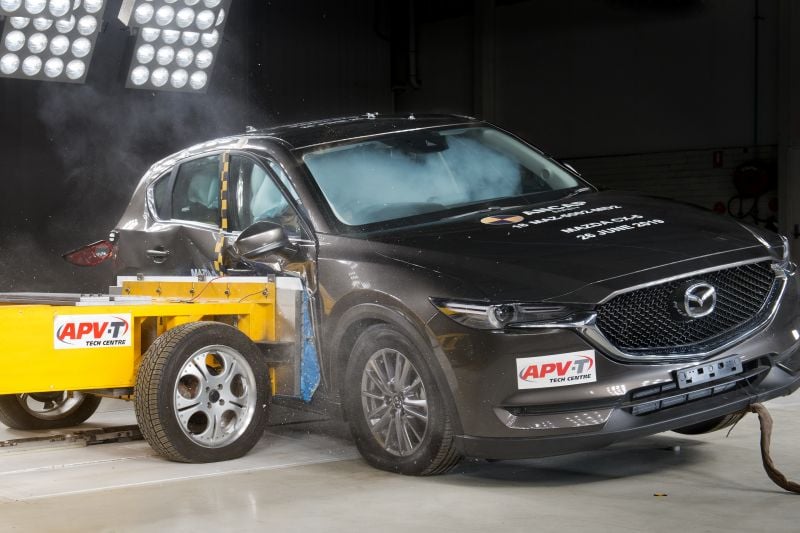
Outdated CX-5 crash test
Standard safety features include:
- Dual frontal, side chest and curtain airbags
- Autonomous emergency braking (AEB)
- Pedestrian detection
- Reverse AEB
- Blind-spot monitoring
- Rear cross-traffic alert
- Lane departure warning
- Lane-keep assist
- Driver attention alert
- Adaptive cruise control with stop/go
- Reverse camera
- Rear parking sensors
- Tyre pressure monitoring
Maxx Sport and up get traffic sign recognition, Touring and up get front parking sensors, while the GT SP and Akera get Mazda’s Cruising and Traffic Support system. The Akera also gets a surround-view monitor.
To see how the Mazda CX-5 stacks up against its rivals, use our comparison tool
How much does the Mazda CX-5 cost to run?
The Mazda CX-5 is backed by a five-year, unlimited-kilometre warranty. Servicing is required every 12 months or 15,000km, with capped-price service costs for the first seven visits are outlined below.
| Servicing and Warranty | Mazda CX-5 G35 |
|---|---|
| Warranty | 5 years, unlimited kilometres |
| Roadside assistance | 5 years |
| Service intervals | 12 months, 15,000km |
| Capped-price servicing | 7 years |
| Average annual capped-price service cost | $510.14 |
| Total capped-price service cost | $3571 |
The G35 is the dearest to run of the three available CX-5 engine grades, costing $491 and $447 more than the G20 and G25 respectively over seven years.
| Service interval | Mazda CX-5 G35 |
|---|---|
| 12 months/15,000km | $366 |
| 24 months/30,000km | $544 |
| 36 months/45,000km | $451 |
| 48 months/60,000km | $849 |
| 60 months/75,000km | $366 |
| 72 months/90,000km | $629 |
| 84 months/105,000km | $366 |
For context, Toyota caps the first five services of its RAV4 at $260 each for a total of $1300, while Mitsubishi does the same for the first 10 non-hybrid Outlander services – totalling $4340 over 10 years, or $2740 over seven – so this CX-5 turbo will cost you more to maintain.
To see how the Mazda CX-5 stacks up against its rivals, use our comparison tool
CarExpert’s Take on the Mazda CX-5 G35 Akera
The G35 is plenty of fun, but it’s not the one to go for if a practical SUV is all you need.
As a starting point, it’s hard to go wrong with the CX-5. It’s cheaper than comparable rivals, as well as comfortable and fairly luxurious in its presentation – despite now getting a little long in the tooth in 2025.
Practicality is good, and the on-road package you get right across the range makes it all the car you’d ever need.
That’s why the G35 engine is really just superfluous; it’s there for customers who have a little more cash to splash on a classy mid-size SUV with extra performance, both in terms of purchase price and running costs.
While it’s more powerful, the biggest advantage of the G35 is that it doesn’t have to work as hard, whether it’s around town or out on the open road, plus you get 200kg of extra towing capacity.
However, while the G35 is fun but impractical, the CX-5’s G20 2.0-litre engine is a little strained even in the considerably smaller Mazda 3, let alone a 1700kg SUV.
Therefore, we’d suggest the naturally aspirated 2.5-litre G25 is probably the best pick for the CX-5, which is probably why it dominates in this SUV lineup.
You’ll also save upwards of $3000 by going for an equivalent G25, and that makes it competitive in this segment.
There’s still no electrification to match the RAV4, Sportage, Tucson, X-Trail, Honda CR-V or even the incoming Subaru Forester, but that will be remedied when the next-generation CX-5 arrives some time in 2026.
Interested in buying a Mazda CX-5? Get in touch with one of CarExpert’s trusted dealers here
Click the images for the full gallery
MORE: Everything Mazda CX-5
